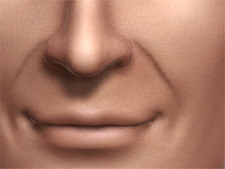Skin forms the largest organ of the body – accounting for about 16 per cent of a person’s weight. It performs many vital roles as both a barrier and a regulating influence between the outside world and the controlled environment within our bodies. The evaporation of sweat from the skin greatly increases the rate at which heat can be lost from the body. The physical toughness of the skin prevents the ingress of harmful chemicals and invading organisms, such as bacteria and viruses. It also provides resistance to shocks for the more sensitive tissues underneath. At the same time, skin needs to be supple and be able to stretch to accommodate movement.
Skin exposed to sunlight is the main site of manufacture of vitamin D, which is essential for the growth and maintenance of our bones. The extensive network of nerves, within the skin, feeds information constantly to the brain concerning our surroundings. On the one hand we are warned of harmful extremes of temperature or of other dangers – while on the other, touch can be one of the most powerfully soothing and pleasurable of sensations.
Much importance is attached to the appearance of skin, especially in our modern society. Conditions affecting the skin can have marked effects, not only on our state of well being but also on the ways we interact with other people, on our suitability for certain occupations and on the sorts of pastimes we can enjoy. So it’s important to understand the importance of good skin care routines for maintaining and improving skin health. Natural products that work in harmony with the skin are the best option for skin rejuvenation.
The structure of human skin is complex, but can be divided into 3 main layers : Epidermis, Dermis, Hypodermis (Subcutaneous Tissue).
Epidermis is the uppermost layer consisting of several layers of cells. The first few layers of cell are dead. The cells beneath them divide and add new cells. Since the uppermost layer of the cell consists of dead cells. They don’t have any blood supply. The lowest part of the epidermis needs blood supply as it needs raw materials to grow and divide. The cell contains certain pigments that give color to the skin. Our skin depends on amount of pigment present in the layers. The pigment is called melanin.
Dermis is the lower layer. It is tough and a strong. I gets rich supply of blood and lymph. You will also find roots of hair embedded in this layer. The crown of the hair over looks the epidermis. Associated with root hair and opening of the cavity (follicle) are the sebaceous glands or oil glands. They keep the hair smooth and soft. You will also find number of sweat glands, when you see the skin with a lens. The sweat glands filter the fluid or sweat from the blood that circulated through the capillaries.
Hypodermis – Subcutaneous Tissue
The subcutaneous tissue is a layer of fat and connective tissue that houses larger blood vessels and nerves. This layer is important is the regulation of temperature of the skin itself and the body. The size of this layer varies throughout the body and from person to person.
The skin is a complicated structure with many functions. If any of the components in the skin are not working properly, a rash or abnormal sensation is the result. The whole specialty of dermatology is devoted to understanding the skin, what can go wrong, and what to do if something does go wrong. Dermatologists also study the ageing of skin and research the most effective treatments for wrinkles, lines, age spots, crows feet, etc.
They have identified a powerful solution for treating the signs of aging and restoring healthy, smooth skin. It’s called LifeCell. An all-in-one anti ageing cream that has the ability to make skin appear younger and more vibrant, while also providing deep nutrition and rejuvenation to the skin. LifeCell Cream is recommended by dermatologists because it provides a safe, natural way to restore healthy, youthful skin without the need for invasive treatments.
LifeCell contains scientifically researched ingredients and is based on Nobel Prize winning science. It’s rapidly gaining popularity across the world as one of the best anti ageing creams, and is loved by many Hollywood celebrities. But most importantly, it works… and it will work for you. Find out the facts about LifeCell Cream and discover how it will help you achieve smoother, healthier skin.
![]()




